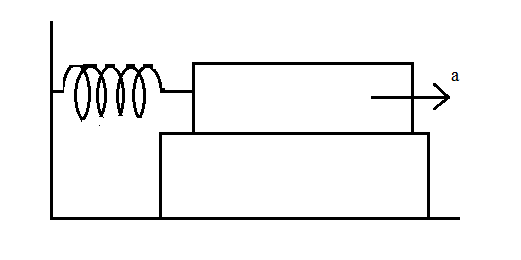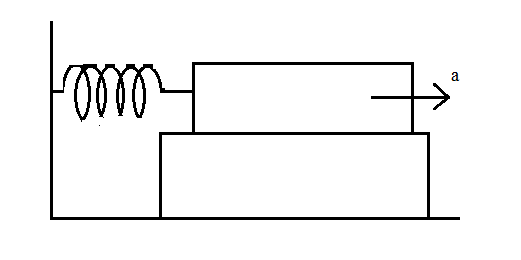
The maximum compression in the spring if the lower block is shifted rightwards with acceleration ‘a’. All surfaces are smooth:

A) \[\dfrac{{ma}}{{2k}}\]
B) \[\dfrac{{2ma}}{k}\]
C) \[\dfrac{{ma}}{k}\]
D) \[\dfrac{{4ma}}{k}\]
Answer
216.6k+ views
Hint: Draw the free body diagram of upper block
Apply work energy kinetic theory for the system.
Complete step by step answer:

As shown in the figure, when the lower block is accelerated in the given direction, the upper block will move in the opposite direction and displacement of the block will be towards the spring.
Let \[k\] be the spring constant.
Let the displacement caused in the spring be \[x\] and force is \[kx\].
Given all surfaces are smooth, therefore, neglecting frictional forces:
When the lower block is moved, a pseudo force of ma acts on the upper block. This force acts in the opposite direction to which the lower block moves.
We know, when there is maximum compression in the spring, final velocity becomes zero.
Initially the block was at rest, thus initial velocity is also zero.
Therefore, we can say change in kinetic energy is also zero.
Now, applying work kinetic energy theorem, we can say:
Work done by all forces must be equal to the change in kinetic energy, which is equal to zero.
Therefore,
The equation becomes:
\[{W_{Sring}} + {W_{pseudo}} = 0\]
Where,
\[{W_{Sring}}\] is the work done due to the spring
\[{W_{pseudo}}\] is the work done due to pseudo force
As shown in the diagram, they are opposite in direction,
So,
\[ - \dfrac{1}{2}k{x^2} + ma = 0\]
As, is the work done due to the spring is= \[\dfrac{1}{2}k{x^2}\]
Therefore,
\[x = \dfrac{{2ma}}{k}\]
So, option (B) is correct.
Note: Pseudo force is referred to as apparent force.
Spring constant determines the stiffness of the spring. When a spring is stretched, it exerts a force which is proportional to the displacement caused in the spring. This constant of proportionality is called the spring constant.
Apply work energy kinetic theory for the system.
Complete step by step answer:

As shown in the figure, when the lower block is accelerated in the given direction, the upper block will move in the opposite direction and displacement of the block will be towards the spring.
Let \[k\] be the spring constant.
Let the displacement caused in the spring be \[x\] and force is \[kx\].
Given all surfaces are smooth, therefore, neglecting frictional forces:
When the lower block is moved, a pseudo force of ma acts on the upper block. This force acts in the opposite direction to which the lower block moves.
We know, when there is maximum compression in the spring, final velocity becomes zero.
Initially the block was at rest, thus initial velocity is also zero.
Therefore, we can say change in kinetic energy is also zero.
Now, applying work kinetic energy theorem, we can say:
Work done by all forces must be equal to the change in kinetic energy, which is equal to zero.
Therefore,
The equation becomes:
\[{W_{Sring}} + {W_{pseudo}} = 0\]
Where,
\[{W_{Sring}}\] is the work done due to the spring
\[{W_{pseudo}}\] is the work done due to pseudo force
As shown in the diagram, they are opposite in direction,
So,
\[ - \dfrac{1}{2}k{x^2} + ma = 0\]
As, is the work done due to the spring is= \[\dfrac{1}{2}k{x^2}\]
Therefore,
\[x = \dfrac{{2ma}}{k}\]
So, option (B) is correct.
Note: Pseudo force is referred to as apparent force.
Spring constant determines the stiffness of the spring. When a spring is stretched, it exerts a force which is proportional to the displacement caused in the spring. This constant of proportionality is called the spring constant.
Recently Updated Pages
JEE Atomic Structure and Chemical Bonding important Concepts and Tips

JEE Amino Acids and Peptides Important Concepts and Tips for Exam Preparation

Electricity and Magnetism Explained: Key Concepts & Applications

Chemical Properties of Hydrogen - Important Concepts for JEE Exam Preparation

JEE Energetics Important Concepts and Tips for Exam Preparation

JEE Isolation, Preparation and Properties of Non-metals Important Concepts and Tips for Exam Preparation

Trending doubts
JEE Main 2026: Application Form Open, Exam Dates, Syllabus, Eligibility & Question Papers

Derivation of Equation of Trajectory Explained for Students

Hybridisation in Chemistry – Concept, Types & Applications

Understanding the Angle of Deviation in a Prism

Understanding Collisions: Types and Examples for Students

How to Convert a Galvanometer into an Ammeter or Voltmeter

Other Pages
JEE Advanced Marks vs Ranks 2025: Understanding Category-wise Qualifying Marks and Previous Year Cut-offs

Units And Measurements Class 11 Physics Chapter 1 CBSE Notes - 2025-26

NCERT Solutions For Class 11 Physics Chapter 8 Mechanical Properties Of Solids

Motion in a Straight Line Class 11 Physics Chapter 2 CBSE Notes - 2025-26

NCERT Solutions for Class 11 Physics Chapter 7 Gravitation 2025-26

Understanding Atomic Structure for Beginners




